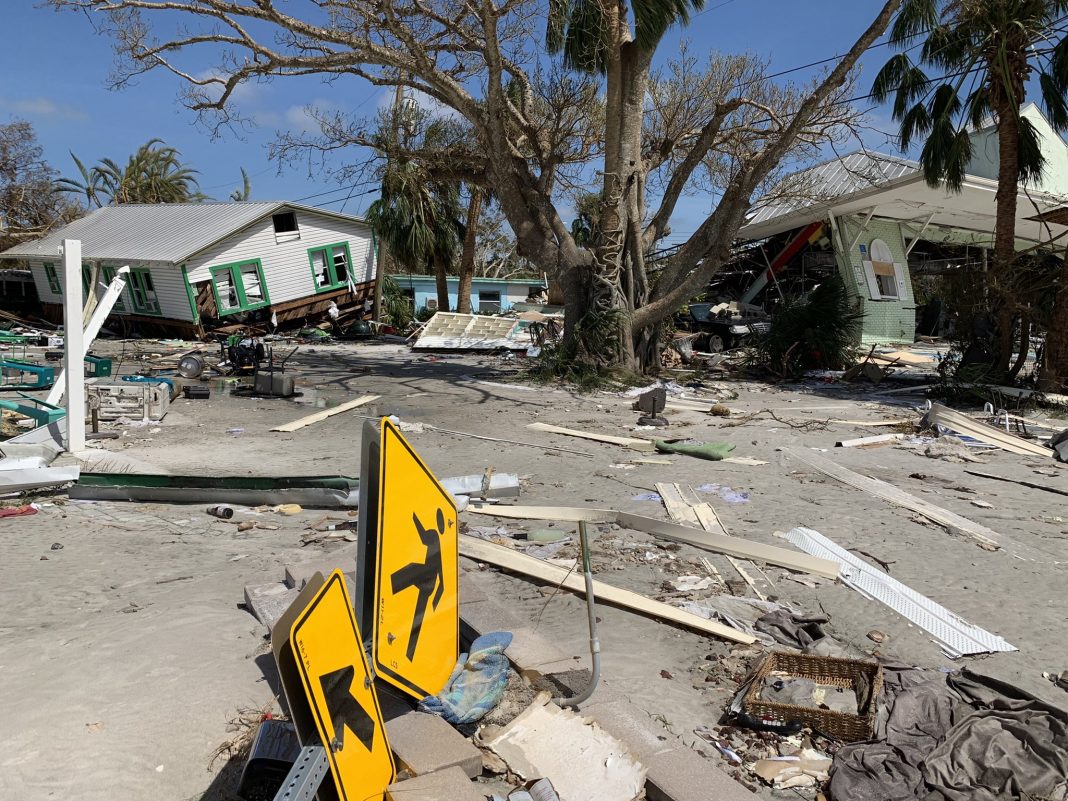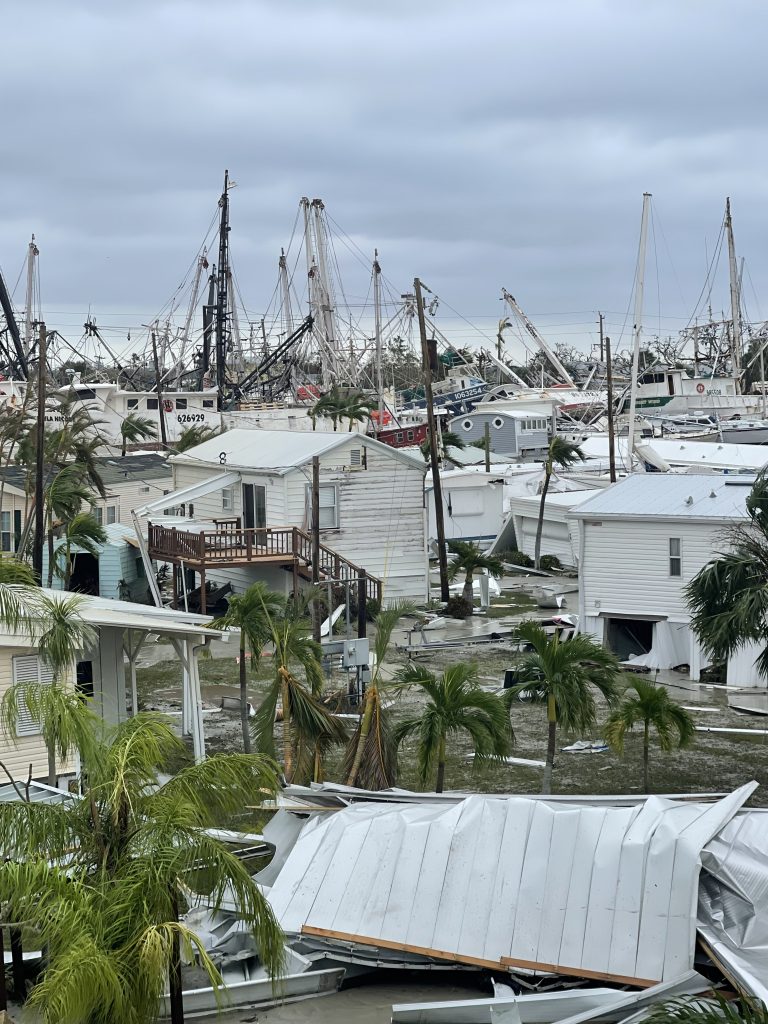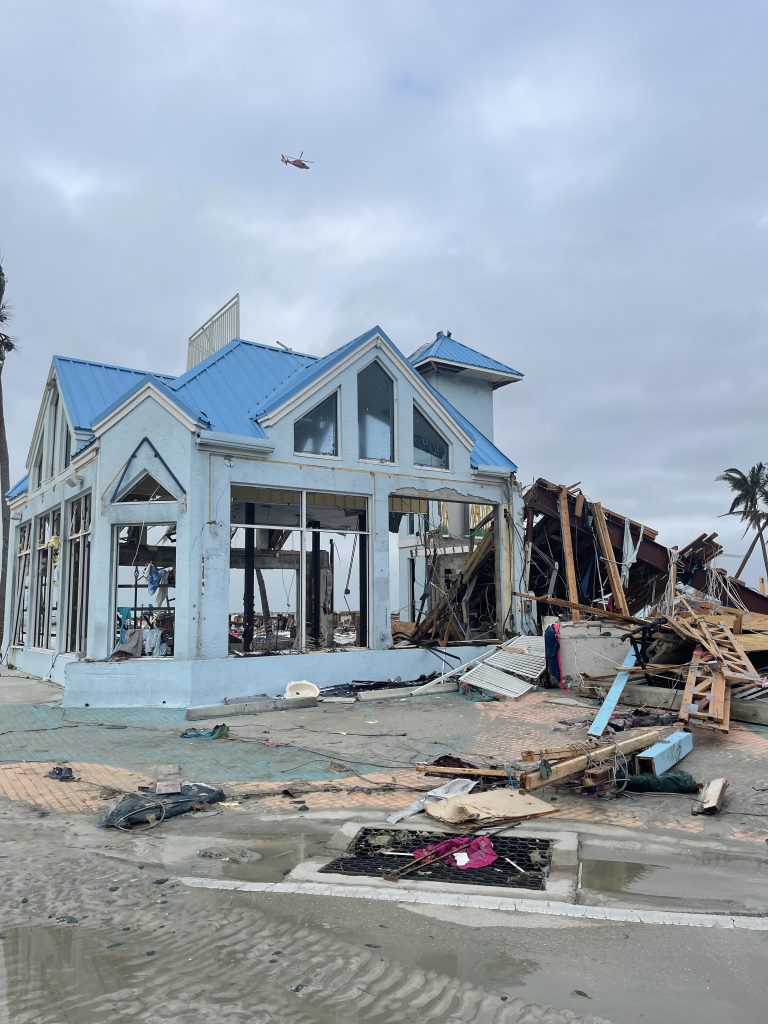

For 138 years the Sanibel Lighthouse has watched over Lee County, Fla. marking the start of the famous shelling island that thousands call home and thousands more escape to for its calm blue water. A symbol of hope and security, the lighthouse is the coastal landmark for Southwest Florida(SWFL).
At 3:05 p.m. on Sept. 28, Hurricane Ian made landfall over Florida as a category 4 storm battering the SWFL barrier islands of Fort Myers Beach, Pine Island, Sanibel Island, Captiva Island and Cayo Costa. Ian then worked its way inward and north, generating a massive storm surge with it that flooded many coastal properties while wind gusts up to 140 miles per hour shredded landscapes.
In the early hours of Sept. 29, amid countless photos of the collapsed Sanibel Causeway Bridge, there, the lighthouse still stood in the distance, continuing to provide light to a community that would need it now more than ever.
Just over 150 miles away at the University of Miami, students from the SWFL community huddled around live news streams of local weather channels, continuously reloaded social media pages for more information and prayed for a text from their loved ones back home.
Caught off guard by the sudden downshift in Hurricane Ian and separated from her family, Naples resident and UM freshman biology major Autumn Eckerd describes watching the storm and destruction unfold from the comfort of her dorm room as a surreal experience.
“Down here we had a little bit of flooding, we had the wind, we had some of the storm,” Eckerd said. “But then I think about farther north and people are going through some of the worst things they have ever gone through and we’re all down here just continuing on with life as normal. It’s really hard to see”
Lingering over SWFL for hours, Hurricane Ian poured more than 20 inches of rain and brought an estimated 18 feet of storm surge that raised river levels to record highs and swept away the coast.
“I saw pictures of probably three feet, four feet of water in our garage. And so at that point, I was getting kind of scared and nervous and trying to text and call my family but no response. No response from anyone because the cell towers had been knocked down,” sophomore nursing major Sadie Collins said. “I didn’t know what was happening.”
Collins and her family live on Connie Mack Island, on the bayside waterfront in Fort Myers, Fla. and a short drive from Sanibel. Her family chose to stay for the storm and watched as water rushed into their first floor, flooding both their cars, destroying their dock and throwing their boat into the side of their house.
While the damages to their home are repairable, the wider Sanibel community faces a much different fate as entire homes have been ripped off their foundation and carried into the ocean or left dismantled as a pile of debris.
“My whole life, everything I had known —my schools, my community, our parks — everything was gone,” Collins said. “I feel like my whole life was kind of oriented around Sanibel and I don’t know when or if that will come back or ever be what it was.”

The fifth strongest storm to hit the United States (an eight-way tie), Hurricane Ian is expected to cost up to $75 billion in damages and has claimed the lives of over 100 people in Florida alone, with the number continuing to rise as search-and rescue-missions persist. 55 of these deaths are from Lee County alone, which includes Sanibel and Pine Island.
A less frequented tourist area, Pine Island did not receive the same early outpour of memoriam posts as neighboring Fort Myers Beach and Sanibel did, despite suffering nearly equivalent damages. Only Matlacha, the locally-loved, spunky, Leoma Lovegrove-painted stretch of land lined with restaurants and shops garnered as much attention. This community, which surrounds the bridge that serves as the only road entry point to the island, was decimated by Hurricane Ian making the area inhospitable and the bridge impassable.
“Seeing Matlacha kind of flattened and seeing houses that I’ve literally seen over a trillion times, I think that’s what gets me the most. When you see it, you understand how it’s never going to be the same or like it’s gonna take so, so long to even be okay,” Ava Diamond, a sophomore studying political science said.
Diamond has spent 18 years of her life as a Pine Island resident. Her father works as a captain on the island whose industry is centered around ecotourism and fishing.
True to his calling, her father rode out the storm on the yacht he currently captains, losing all contact with his family, who had sheltered inland with a relative, for over six hours. It was not until Diamond’s mother called the coast guard that they were able to confirm he was alive.
“It would pop in my head like, ‘Oh my God, my dad’s dead. What am I going to do if my dad is dead?” Diamond said. “Obviously everything was fine, but I did feel really uncertain.”
Once learning her family was safe, Diamond turned her attention to her ravaged community, and how their socioeconomic status differentiates them from Sanibel.
“My perspective is that people on Sanibel are a lot richer. I don’t think that anybody’s experience is better or worse when it comes to a natural disaster because in the moment it hits everyone the same, but realistically it’s not. It’s not the same for people in different tax brackets, with the exception of the endangerment of your actual life,” Diamond said.
According to the 2020 U.S. Census, the median household income for Sanibel is $92,875, almost double the Pine Island median household income of $46,284 as reported by Data USA.
Diamond worries that this will limit the ability of Pine Island and Matlacha to recover from Hurricane Ian as quickly as Fort Myers Beach and Sanibel. She also believes they received the early brunt of aid due to their tourism preference and higher wealth status.
“It’s weird that the only people taking in food and water are regular people,” Diamond said.“Why is my dad taking an old lady from her house and bringing her to Cape Coral because she thought she was going to die? Why is my mom taking $1,000 of groceries and bringing them to the island?”
In a press conference on Oct. 4 Florida Governor Ron DeSantis addressed the lack of focus on Pine Island, announcing the approved construction of a temporary bridge to the mainland he hopes will alleviate the pressure on families in this area.
“I probably saw more debris on Pine Island than any place I’d been other than Fort Myers Beach,” DeSantis said. “No one had done anything about the power over there.”

This issue extends up the coast as residents of less-popular and less news-covered areas struggle to get back on their feet. North Port, Fla., slightly north of Cape Coral, Fla., was reported to have the worst standing water problem in Florida after the Myakka River raised to 12.7 feet, following Ian’s torrential downpour. Yet, the community has received nearly no attention in the media spotlight.
“This had broad impacts. It’s not just where the almost [Category] 5 winds hit,” DeSantis said in a comment to the Herald Tribune. “This was a massive, slow-moving storm that dumped a historic amount of water on our communities and places like North Port have produced historic flooding. That’s in some ways a more difficult problem than even the wind damage.”
With the approval of the Florida Disaster Declaration, federal funds will be opened up to the affected communities of Charlotte, Collier, DeSoto, Hardee, Hillsborough, Lee, Manatee, Pinellas and Sarasota counties. While Federal Emergency Management Agency aid and state resources will be crucial to the rebuilding process, it is the local response that has been felt strongest so far.
“I will say the silver lining of all of this is seeing our community all come together to help each other. I feel like everyone I know is posting resources,” Collins said.
The expertise local guides have on the water has allowed regular citizens to become critical resources in relocating people from the now cut-off islands and delivering necessary supplies to those in the hardest hit areas.
Collins got involved in the SWFL-based Captains for Clean Water ‘Operation for Ian Relief’ by gathering donations from friends to supply the resource line they are running directly to the islands. The organization has established drop-off points throughout the state, connecting their family of boat captains and water-lovers. Collins has stayed involved by starting a fundraiser within the UM National Student Nurses Association.
“We were trying to find something I know that’s local that would help my community specifically, and I saw Captains for Clean Water had posted something where 100% of the donations would go towards relief, whether it’s providing generators and water or rescuing people. So I was like, this is perfect,” Collins said.
On Pine Island, Diamond sees how the small-community feel has turned neighbors into family, all working to help one another however they can until more government aid is provided.
“Because it’s such a small place everyone really does hyper-focus on each other and you know, do what they’ve got to do for their own community. And that’s really beautiful, but it’s not enough because you can only do so much. Especially when you’re not in a position of power,” Diamond said.
Donations have been pouring into SWFL over the past week, with over $35 million raised for the Florida Disaster Fund alone.
Within the UM campus though, next to no action has been taken to support those affected by Hurricane Ian with the exception of a statement from President Julio Frenk and Vice President of Students Affairs Patricia Whitley.
“If it wasn’t for my own posts on my own Instagram, half of the people here that I know would have no idea how bad it is.” Collins said. “All everyone’s talking about is the destruction of the causeway or the buildings, which is so horrible, but I feel like they’re not acknowledging what goes behind all that. That’s someone’s house. That’s someone’s business. You know, that’s someone’s neighbor.”
Collins had hoped the university would have mobilized its resources to take charge in the rebuilding process, not only because of the love she has for her hometown, but because she feels so many students are reeling from the impact of the storm.
“I think it’s not been given nearly as much attention as it needs considering it’s just two hours across the state,” Collins said. “So many students here have the financial ability to help and want to help and don’t know how because they just don’t have the resources.”
The rest of the Miami-Dade community, however, has been stepping up to funnel aid into SWFL. From Croqueta Day fundraiser events at Sergio’s restaurant to supply collection drives through 305 Gives Back – the Miami presence across the state is strong.
Hurricane Ian relief has been undertaken in mass scale through the Miami-Dade County partnership with the Global Empowerment Mission from their Doral headquarters.
“After following the eye of the hurricane GEM was able to address immediate needs after our own assessment. With the help of our trusted partnerships, we were able to acquire a central distribution hub and service those affected by Hurricane Ian. With the help of our volunteers in our headquarters in Doral, GEM has supplied over 10,000 families with Family Necessities Kits and supplies,” Lee Harrison, GEM relations officer, said in a general statement to The Miami Hurricane.
For students, faculty and the wider-UM community looking to get involved or donate, resources can be found at volunteerflorida.org and globalempowermentmission.org. For more local funds, the News-press has compiled a list found at new-press.com.





